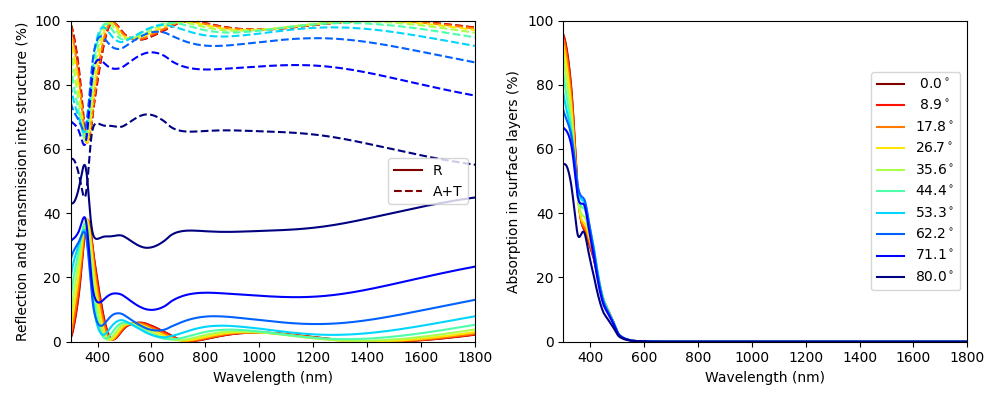import matplotlib.pyplot as plt
import numpy as np
from solcore.solar_cell import Layer
from solcore.absorption_calculator import calculate_rat, OptiStack
from solcore import material, si
wl = np.linspace(300, 1900, 1000)
MgF2 = material("MgF2")()
HfO2 = material("HfO2")()
ZnS = material("ZnScub")()
AlInP = material("AlInP")(Al=0.52)
GaInP = material("GaInP")(In=0.49)
stack = OptiStack([
Layer(si('141nm'), material=MgF2),
Layer(si('82nm'), material=HfO2),
Layer(si('70nm'), material=ZnS),
Layer(si('25nm'), material=AlInP),
], substrate=GaInP, no_back_reflection=False)
angles = np.linspace(0, 80, 10)
RAT_angles = np.zeros((len(angles), 3, len(wl)))
print("Calculate RAT:")
for i, theta in enumerate(angles):
print("Calculating at angle: %4.1f deg" % theta)
# Calculate RAT data...
rat_data = calculate_rat(stack, angle=theta, wavelength=wl,
no_back_reflection=False)
RAT_angles[i] = [rat_data["R"], rat_data["A"], rat_data["T"]]
colors = plt.cm.jet(np.linspace(1, 0, len(RAT_angles)))
fig, (ax1, ax2) = plt.subplots(1, 2, figsize=(10, 4))
for i, RAT in enumerate(RAT_angles):
if i == 0:
ax1.plot(wl, RAT[0] * 100, ls="-", color=colors[i], label="R")
ax1.plot(wl, (RAT[1] + RAT[2]) * 100, ls="--", color=colors[i], label="A+T")
else:
ax1.plot(wl, RAT[0] * 100, ls="-", color=colors[i])
ax1.plot(wl, (RAT[1] + RAT[2]) * 100, ls="--", color=colors[i])
ax2.plot(wl, RAT[1]*100, color=colors[i], label="%4.1f$^\circ$" % angles[i])
ax1.set_ylim([0, 100])
ax1.set_xlim([300, 1800])
ax1.set_xlabel("Wavelength (nm)")
ax1.set_ylabel("Reflection and transmission into structure (%)")
ax1.legend(loc=5)
ax2.set_ylim([0, 100])
ax2.set_xlim([300, 1800])
ax2.set_xlabel("Wavelength (nm)")
ax2.set_ylabel("Absorption in surface layers (%)")
ax2.legend(loc=5)
plt.tight_layout()
plt.show()
